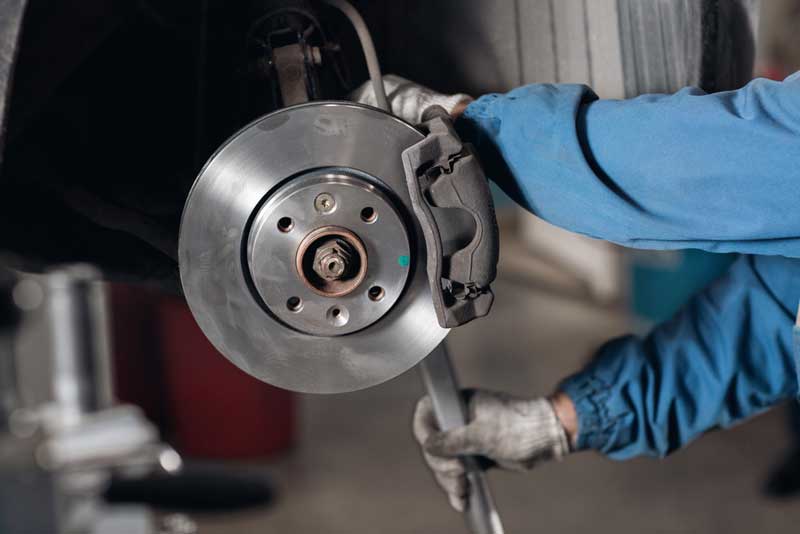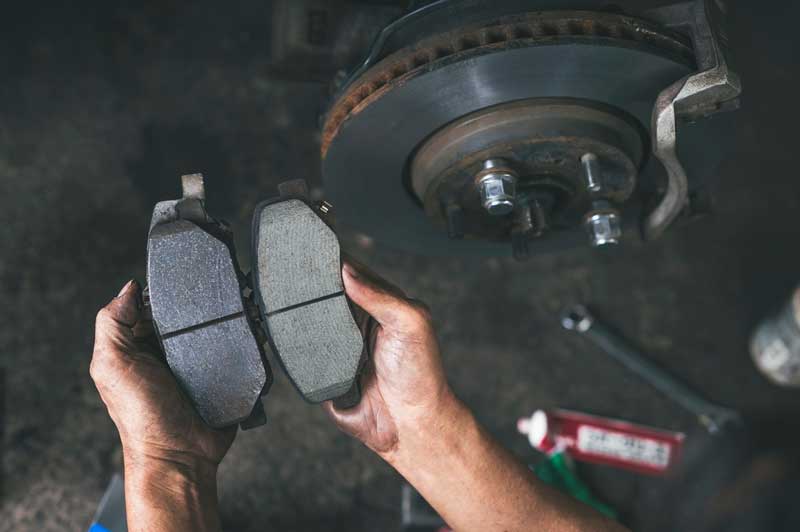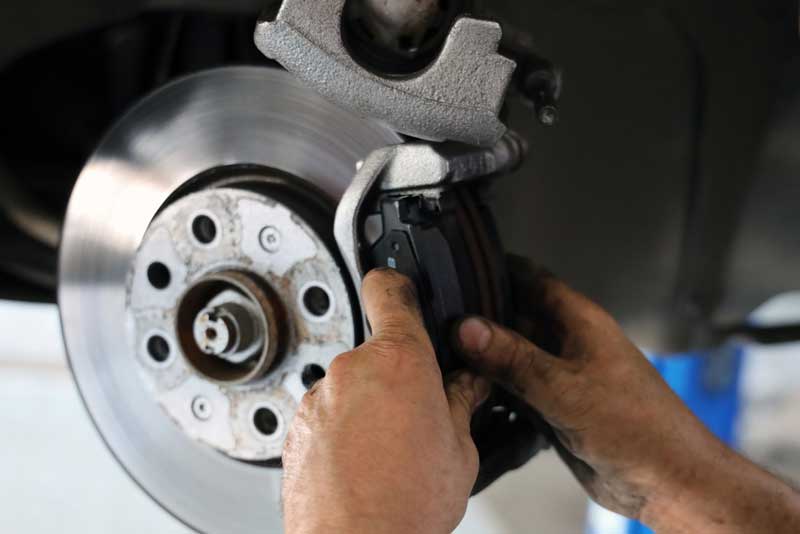Are you considering a change of brake pads? Are you searching to know how much dose brake pad replacement cost?
A primary concern for drivers is pressing the brakes and not getting any results. The brake pads are the most critical component of the braking system and the key to stopping the vehicle. The vehicle may have problems stopping if the brake pads get overly worn. The least that could happen is that the car stops farther away from the intended point, which could be risky.
How much should be put in the budget for replacement when changing the brake pads? We will cover everything that needs to be known about replacing brake pads, from the cost to how the vehicle owner may carry out the replacement by himself.
How much Does Brake Pad Replacement Cost
On average, brake pad replacement costs range from $150 to $300 per axle. This is dependent on the brake pad material of your vehicle. The least expensive brake pads are made of organic material.
Brake rotor and pad replacement usually cost around $600 for an axle if the rotors need to be replaced simultaneously with the pads. The prices of semi-metallic and organic pads are not too high. In most circumstances, a set of brake pads can be obtained for around $50. Remember that this set can only be used at the back or front, not both. Usually, the cost of front and back pads is not so far from each other.
It could cost about $150 to $200 on the pads if the vehicle needs ceramic brake pads or if the vehicle owner chooses to get enhanced aftermarket parts from Wagner or Akebono. Because high-end cars require significantly more expensive parts, the brand, as well as the model of a vehicle, has a significant impact on the repair cost. For example, a Mercedes-AMG brake pad goes $200, compared to the $40 paid for Honda Accord brake pads.
The labor expenses range from $75 to $150 for a normal brake job that takes a competent technician up to one hour to conclude just the pad replacement. Rotor replacement will almost certainly increase the time needed. Although coughing up money to change a vehicle’s brakes may look unnecessary, proper maintenance of a vehicle’s brakes is a thing to take seriously.
How Much Would It Cost You to Replace All 4 Brake Pads?
Replacing each brake pad for each wheel costs between $230 – $600. These materials come in a variety of grades, from cheap to expensive..
Cost of Front Brake Pad Replacement
The front brakes perform about 70% of the time the vehicle’s braking. Unfortunately, these brake pads frequently overheat, which can cause them to screech, grind or grunt. The average price of replacing front pads is around $115 to $300, comparable to replacing the rear pads. These materials come in various grades, from cheap and low-quality to expensive and high-quality ones.
Cost of Rear Brake Pad Replacement
The rear brakes help stop a vehicle, but they only provide roughly 30 to 40 percent of the braking force. They should therefore last longer, right? Unfortunately, the rear brake pads will wear out more slowly than those at the front because they are smaller. If the rear brake pads wear out, anticipate that the front brake pads will follow soon after. Around the same price is needed to replace both the front and rear brake pads, and to replace the rear pads may range from $115 to $300. These materials come in a variety of grades, from cheap to expensive.
Also Read: Head Gasket Replacement Cost
What Are Brake Pads, and What are Their Functions?
Let’s discuss a vehicle’s braking system generally and how brake pads fit in before we get into the specifics of brake pad replacement. The entire system is made up of more parts than only brake pads.
Since earlier cars’ braking drums contain brake shoes rather than brake pads, we shall solely examine disc brake systems. First, each wheel on the vehicle is equipped with braking rotors. Because the wheel and rotor are coupled, when the wheels turn, so do the rotors.
Brake calipers are resting on these rotors. The caliper has one on all sides of the brake rotor and has a form resembling the letter “C.” They are placed near the brake rotors, although they do not interact with them. The pads are located inside the calipers. The vehicle slows down and stops when the brake pads touch the rotor.
When the brake pedal is stepped on, the hydraulic brake oil is passed into the calipers. When this occurs, the pads are forced against the brake rotors by hydraulic pressure applied by the calipers. The vehicle tires start slowing down and eventually stop when the brake pads firm up on the rotors. The brake pads will have a more forceful contact with the rotor the harder the brake pedal is being pushed.
Several different materials can be used to make brake pads. The most popular kinds are semi-metallic, ceramic, and organic materials (non-metallic brake pads). Every category has advantages and disadvantages, and which one is preferred depends on the application. For example, a person who drives daily needs brake pads different from a sports car.

Symptoms of Worn or Bad Brake Pads
1. Wear Indicator Shows Up
When there are 2-3 mm or 0.04′′ – 0.1′′ of the brake pad material left, most contemporary cars include brake wear indicators. Check the brake pads if the wear indicator appears on the vehicle’s dashboard.
Although checking the vehicle is necessary when the light comes on, the indicator connector and cables can cause false alerts on the vehicle’s dashboard.
However, a few cars have wear indicators on the two axles, while the majority only have them on the front brakes.
2. Brake Pedal Becomes Spongy
If, when pushing the brake lever, it is discovered that it has become mushy, a bad pad may be the cause. Likewise, when the brake pedal is pushed, the pedal plate will bend due to pieces coming loose from the brake pad.
It is frequently necessary to remove the brake pedals for inspection to check the damaged pads by components that became loose. A serious check from a distance may be insufficient.
3. Grinding or Squealing Noise
If when pressing the brake lever and a screaming or grinding sound is heard, the pads may be entirely worn out. The reason for this could be because the sound of a metal plate being heard could be the brake pad pressing against the metal rotor when the pad material is fully gone.
When a metal makes contact with another metal, the sound is always awful, as expected. So it’s time to examine brake pads if a terrible screech is heard when the brake is pressed.
4. Longer Brake Distance
A substantially longer stopping distance will result from a brake pad wearing down to its metal plate. This is because stopping a car requires less friction when metal is in contact with another metal.
Another possibility is that some brake pad components broke loose, reducing friction between the rotor and the brake pad.
5. Scratches on the Brake Rotor Surface
It can be because the brake pad is so worn that it reached the metal plate if ugly scratches are seen, and the rotor’s surface looks odd.
If the surface of other brake rotors on the vehicle is checked, this is frequently extremely obvious.
How Regularly Can I Perform Brake Pad & Rotor Replacement?
How long will a brake pad last, and how frequently should it be replaced? The average car needs new brake pads every 40,000 – 60,000 miles. Naturally, this will depend on the model and brand of the vehicle as well as the driving style. A vehicle’s brake pads won’t last as long as those on a vehicle that usually travels on highways if the vehicle is used every day and frequently stop in traffic.
Additionally, the brake pads on a car can have softer friction material that needs to be replaced after driving a distance of 20,000 miles. On the other hand, a set of pads can last for 75,000.
Since no general solution applies to everyone, it relies on the particular circumstance. Because the brake pads should be replaced as needed and not just after a predetermined number of miles, the owner’s manual will typically not give a recommended frequency.
Common Factors That Affect Your Brake Pads
Below are some factors which will affect the life of your break pads:
- Driving Habits: Brake pads might wear out faster if the brake is used frequently and the driver stops swiftly.
- Driving Environment: The brake pads may be affected by slow-moving traffic and mountainous terrain where there is the need to control downhill speeds faster.
- Materials: There are various materials used to make brake pads, and each has a varied impact on durability.
- Condition of Brake Rotors and Calipers: The brake pads are made to perform in harmony with calipers and rotors, among other brake parts. These can impact the brake pads if they are not in good shape.
How to Inspect Your Brake Pads
In an automobile, checking the brake pads is frequently fairly simple. Only a flashlight is all that is needed. Focus the flashlight on the rotors inside the rim.
Check the area shown in the image above to see if the brake pad still has a minimum of 0.15 – 0.2 inches (4-5 mm) of life before deciding whether to replace it.
Seeing the brake pads from the outer side of some rims may be challenging. In this situation, it may be necessary to take the wheel off to inspect it.
Removing the rim for inspection or viewing it with a small mirror is strongly advised because it happens more regularly to have the inner brake pad wear out before the outer brake pads.

How to Replace Your Brake Pad Yourself
Are you looking to save the large brake pad replacement cost? A vehicle owner may change his brake pads to cut costs because the vehicle’s brake pads only account for a small portion of the replacement cost. With a little mechanical knowledge, changing a vehicle’s brake pads is not too difficult. A lot of mechanics perform this project regularly. Continue reading if there are any questions about how to replace brake pads.
First of all, take out the wheel. The majority choose to focus on a wheel at a time. The caliper should then be unbolted and removed. To aid in releasing the caliper, insert a screwdriver between the rotor and the old brake pads. When removing the caliper, take care not to harm the brake cables!
Then proceed to take the old pads out of the caliper. Once the old pads are removed, the piston may need to be forced back into the caliper using a clamp or similar tool. If this step is neglected, it will not be possible to wrap the replacement pads around the brake rotor.
Place the new parts and pads inside the caliper once the piston has been forced in, then replace the caliper around the rotor.
At the opposite wheel on the same axle, repeat this process. Once finished, turn on the vehicle and gradually depress the brake pedal. Most likely, it will practically touch the ground. Release the brake pedal gradually, then slowly push it down again.
As the pistons move back against the pads after pumping the pedal a few times, it should feel normal once more. The process is concluded once the vehicle has been put on the road and a few abrupt stops have been made to seat the brake pads.
Also Read: Car Blowing White Smoke After Oil Change (Causes & Fix)
Frequently Asked Questions – Brake Pad Replacement Cost
Is it OK to replace brake pads only?
Absolutely. Replacing rotors may only be necessary when the brake pads are changed. If a vehicle owner wants to know when the rotors need to be replaced, the rotor’s thickness should be observed and also checked for corrosion. If not, the brake pads may be changed before putting the vehicle on the road. Seek advice from a specialist or a repair facility is uncertain. When conducting this task on a vehicle with a rebuilt title, be sure to verify all of the braking parts to ensure everything appears to be in order.
Is it cheaper to replace brake pads yourself?
Yes, if a vehicle owner chooses to do the work, he saves cost. However, due to the fact that replacing a brake pad is regarded as a maintenance item, it is usually not covered by warranties. The cost of changing brake pads at an auto workshop will probably be around $300 for each axle; however, it can easily be done by the vehicle owner for less than $100.
How often should brake pads be replaced?
When to change brake pads is a concern for some people. When brake pads become too worn, they should be changed. However, no particular timeframe is fixed for when a replacement should take place.
Most vehicles require new brake pads after covering 40,000 to 60,000 miles. How quickly a vehicle’s pads wear out will depend on the vehicle and driving technique. While a driver might only use pads once every 70,000 miles, another driver might find that they need them every 20,000 miles. Keep an eye on how thick the brake pad is and have the vehicle inspected by a professional mechanic immediately; any sign of a worn brake pad is noticed.
What are the benefits of replacing brake pads?
Brake pad replacement is a necessity that cannot be overlooked. After changing the brake pads, the stopping distance should reduce, which in effect means the vehicle will stop faster and more smoothly. Additionally, fresh pads are probably going to generate less heat, and this can be beneficial for the whole braking system. Last but not least, they may generate a small quantity of brake dust, allowing the wheels to remain cleaner between car washes.
How much does it cost to replace all four brake pads and rotors?
The typical cost of a total brake repair, which includes new pads, rotors, and calipers, ranges from $300 to $800. However, the cost of a full brake job might easily exceed $1,000, although this depends on the brand and model of the vehicle.
How much should a full brake job cost?
There may be a significant price difference depending on the vehicle in question. For example, according to the materials used in making the vehicle’s brake pads, the cost to replace brake pads might range from $150 to $300 per axle on average. The cheapest brake pads are made of organic material.
How much does it cost to change the front brake pads?
Replacement brake pads typically cost $150 for each axle or a maximum of $300 at most. But that is only a rough approximation. Costs per axle might range from $100 – $300. Composite organic properties make up the brake pads that cost less.
Should you replace all four brake pads at once?
Is it advisable to replace all four brake pads at once? First of all, either the front or the rear pads should be replaced simultaneously. This is because they should wear out around the same time unless something goes wrong.
Can I replace brake pads myself?
The task of replacing a vehicle’s brake pads can be done by the vehicle owner himself if there is enough confidence to handle it by himself. As with any auto modification or repair, check the vehicle’s manual for any special instructions or instructions before starting.
Can I just replace brake pads and not rotors?
It also depends on how well the brake rotors are doing. The damaged brake pads can be replaced if the rotors have not gone bad or thinned past the required thickness.
How long does a brake job take?
It depends and could be done in 15 minutes or extended even up to 8 hours to fix a brake. The average time it takes is 1 – 3 hours. Different brake repair kinds exist, some of which need more time than others.
Conclusion – Brake Pad Replacement Cost
Brake pad replacement cost can be low as it is an easy and cheap task. If the vehicle owner chooses to undertake the task himself, it will save him from a lot of expenses because brake pads only cost about $50 for most autos.
Even if the vehicle is taken to a specialist, the repair should only cost about $300 unless the vehicle is really expensive. Make careful to treat the situation immediately after the signs of a worn pad are noticed. Driving on can cause more harm and is exceedingly risky!

